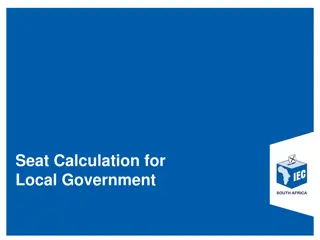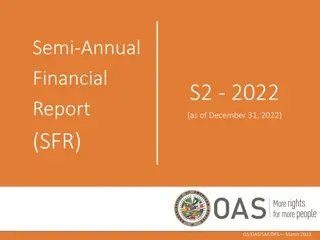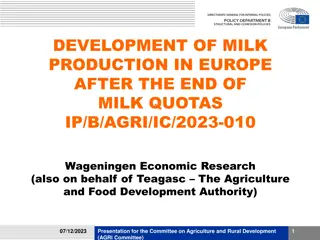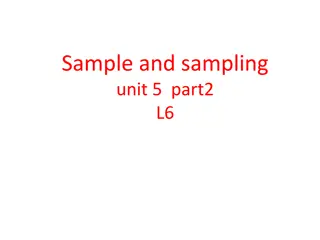Understanding Non-Probability Sampling Methods
Non-probability sampling methods involve selecting samples based on subjective judgment rather than random selection. Types include convenience sampling, quota sampling, judgmental (purposive) sampling, and snowball sampling. Convenience sampling picks easily available samples, quota sampling select
4 views • 7 slides
Understanding Trade Barriers and Tariff Classification
Explore the concept of trade barriers, including tariff and non-tariff barriers, their objectives, types, and classification. Learn about the benefits of tariff barriers, like discouraging imports and protecting home industries, and the classification of non-tariff barriers such as the quota system
3 views • 28 slides
Understanding Market Sharing Cartel in Oligopolistic Markets
Market sharing cartels in oligopolistic markets involve firms entering agreements to share the market while retaining some autonomy in their operations. Two main methods are non-price competition and quota systems. Non-price competition involves firms agreeing on a common price to maintain profits w
0 views • 8 slides
Women's Quota and Gender Equality in Zimbabwe: A Call for Action
Highlighting the impending end of the women's quota system in Zimbabwe by 2023, the article discusses its impact on promoting women's political participation. It explores challenges, successes, and the need for supportive mechanisms to achieve gender parity in politics, emphasizing the importance of
0 views • 12 slides
Local Government Seat Calculation Framework
The legislative framework in South Africa outlines the seat calculation process for local government elections, emphasizing proportional representation. It involves determining quotas for proportionality, allocating seats based on total party votes, and addressing scenarios where parties may have mo
0 views • 8 slides
Understanding Market Sharing Cartels in Oligopolistic Markets
Perfect collusion in oligopolistic markets often involves market-sharing cartels, where member firms agree to share the market while allowing some degree of freedom in their decisions. This can be done through non-price competition or quota agreements. Non-price competition cartels involve setting a
8 views • 8 slides
Semi-Annual Financial Report S2 - 2022 Summary
This report provides key financial data for the second half of 2022, including budgetary execution, fund quotas compliance, member states' balances due, liquidity risk assessment, and more. It outlines the overall program budget execution, quota compliance of member states, and fund liquidity status
0 views • 14 slides
Development of Milk Production in Europe Post-Quota Abolition
The presentation evaluates challenges and opportunities for the EU dairy sector following the abolition of milk quotas in Europe. It reviews policy developments, context, structure, and functioning of the dairy sector. With insights from official data sources and consultation with key industry playe
0 views • 14 slides
Television Content Regulation in Australia
Television content regulation in Australia is overseen by industry-developed codes of practice and specific licence conditions under the Broadcasting Services Act 1992. TV stations hold the primary responsibility to ensure that programs reflect community standards. Regulations cover areas such as to
0 views • 12 slides
Treasury Fund Overview and Analysis
The Treasury Fund is the central repository for all funds managed by the General Secretariat, consolidating cash and bank accounts while accounting for separate funds. The composition, loans, temporary loan history, and quota balance provide a comprehensive snapshot of the Treasury Fund's financial
0 views • 16 slides
Empowering Women in Politics: The Suriname Experience
The 8th Annual Gathering of Women Parliamentarians highlighted the importance of diversifying political power for building inclusive societies. Suriname faces challenges in enacting quota legislation but has seen success in increasing female legislators through non-quota measures. Initiatives focusi
0 views • 9 slides
Understanding Non-Probability Sampling Methods
Non-probability sampling involves selecting samples based on subjective judgment rather than random selection, leading to a lack of equal chances for all population members to participate. Various types include convenience sampling, quota sampling, judgmental sampling, and snowball sampling. Conveni
1 views • 7 slides
Progress and Challenges for Japanese Women in Decision-Making Roles
Japanese women face challenges in decision-making positions, evident in the low ranking on the Global Gender Gap Index. Efforts such as the 2030 Campaign and the Law Regarding Promotion of Active Participation aim to increase female representation. Despite improvements in female participation in pol
0 views • 13 slides
Post-War Issues: Nativism, Red Scare, and Labor Unrest in the 1920s
The 1920s saw a rise in nativism, with Americans feeling threatened by job competition from women and minorities. The era was marked by the Red Scare, fueled by fears of communism spreading globally, leading to the formation of the Ku Klux Klan. The Quota System was implemented to limit immigration,
0 views • 7 slides
Financial Overview of Reductions and Contributions in the United States (2019-2023)
The data highlights reductions in the contributions of the United States from 2019 to 2023, along with the total quota income of other member states. It also includes projected expenses and budgetary reductions applied annually, categorized into personnel and non-personnel. The information provides
0 views • 5 slides
Overview of Texas Exempted Fishing Permit Program and Federal Season Lengths
Texas Exempted Fishing Permit (EFP) program allows Gulf States to lead reef fish management activities. In 2018 and 2019, all five Gulf States received approval for state management. The EFP requested 16% of the overall recreational quota in Texas based on past preferences. The program is required t
0 views • 16 slides
Understanding Non-Probability Sampling Methods
Non-probability sampling involves selecting samples based on subjective judgement rather than random selection. This method may not give all population members an equal chance to participate. Types include convenience sampling, quota sampling, judgemental sampling, and snowball sampling.
0 views • 7 slides
Understanding Non-Probability Sampling Techniques in Nursing Research
Non-probability sampling in nursing research involves selecting samples subjectively rather than randomly. This sampling method carries a higher risk of bias and limits statistical inference about the entire population. Five main types include convenience, purposive, quota, snowball, and voluntary r
0 views • 30 slides
Germany's 90,000 Work Visa Initiative A New Chapter for Indian Talent
Germany has embarked on a transformative journey by significantly increasing its annual work visa quota for Indian professionals from 20,000 to an impressive 90,000. This pivotal decision addresses the country\u2019s pressing labor shortages in key s
2 views • 7 slides
Challenges and Solutions in Implementing PCT Fee Reductions for Universities
Implementing fee reductions for universities under the PCT system involves defining eligibility, counting reductions, claiming reductions, ensuring consistency across Receiving Offices, and monitoring quota usage. Challenges include defining university eligibility, handling multiple applicants, and
0 views • 8 slides



















